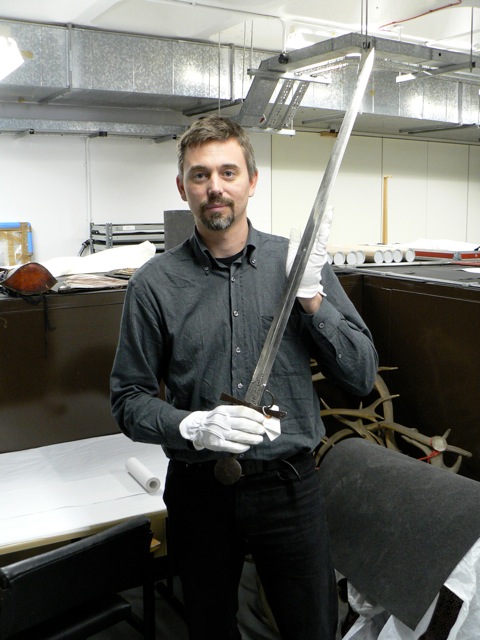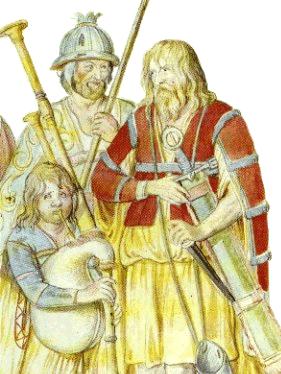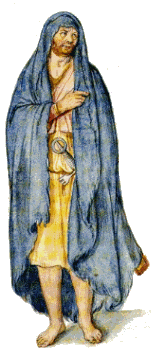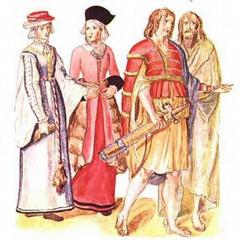Posts: 630 Location: Tucson
Fri 22 Jan, 2010 11:08 am
Yes, well it all comes back to the five golden research questions, who, where, when how and why. I have some thoughts on the matter but please don't take anything as definitive and I am typing "off the top of my head so to speak. Aussi, en francais n'est pas un probleme......
Who.
There is an inherent problem dating and ascribing the ring hilted swords found in Ireland. To my knowledge, none of the effigies in Ireland show them (I am open to correction on this), and there are (to my knowledge) no written records of said swords in surviving documents such as wills, testimonies etc. As McCoy originally stated when he first published his work in the 70s, there were clearly three distinct military cultures in Ireland in the late 15th and early 16th c.: English (pale), Anglo-Irish outside of the pale, and Scots-Irish. . Each seems to have had distinctive weapon and armour preferences although, as this was a poorer fringe of Europe in the 16th c. one would expect a bit of mixing. So we have the old argument again of what do we mean when we use the term "Irish" in this context. Where the ring-hilted swords fit in culturally, is as far as I know, still a matter of debate. I would suggest the most likely affiliation is outside of the Pale.
When
Given the lack of any supporting documentation or cultural evidence, it seems odd and rather counter intuitive to me that these ring hilted swords (for which there is evidence that some had plates covering the ring) would have a long running cultural affiliation. that is, that they would represent a long running style over many decades let alone multiple centuries. I think the minimal supporting cultural documentation seems to this layman, to indicate the exact opposite, that these swords may have all originated in a rather narrow time window. The fact that the majority of surviving blades with ring hilts seem to have ricassos, are multi-fullered, have styles of cross that are indicative of late 15th and early 16th c., and have blade cross sections similar to
Oakeshott types XIX and XX, again indicate to me that they may have been manufactured within a relatively small window in time. When, however, is still rather perplexing. The Durer woodcut does give us one point in time, 1521, although interestingly, it is of Irish mercenaries outside of Ireland. Yet it is really the only reliable dated piece of evidence we have for ring hilts. I would also like to point out that none of the artwork of the Elizabethan Wars show them. I think the most logical conclusion is therefore that this style of sword dates to the early 16th c.
Where
As to the question of where, the finds all seem limited to Ireland and the one or two drawings we have of ring hilted swords are of Irish Mercenaries, which is I think a pretty strong argument that the hilts are of Irish manufacture. Dublin, Waterford, Limerick? who knows? The source of the blades as discussed above, is problematic but would have been imported from somewhere on the continent
How
We know that there was much sea-going trade going on between Ireland and mainland Europe via Limerick, Waterford, Kinsale, Cork etc, that was beyond the control of Dublin in the 16th c.
Why
One of the many interesting aspects of these swords is that they are not crude - quite the opposite - the hilts are rather finely made and well crafted and have a somewhat individual character to them. This imho, points to manufacture by a limited number of craftsmen, possibly even just one shop. but that is just my theory.
In summary, I am just a layman, but have also had this as an area of primary interest spanning two decades.+
I believe the evidence supports a rather narrow time frame of manufacture, using imported blades (I like the idea of Italian or Spanish manufacture but leave that portion of the story to those far more knowledgeable than me), hilted in a shop somewhere outside of Dublin, commissioned by Noble(s) outside of the Pale, probably in the first few decades of the 16th c.
And I don't think we can rule out the possibility, its just a possibility mind you, that nearly all of these swords were put together in a very small time period, literally a period of a year or two or less, by a Noble outfitting a mercenary army prior to embarking for mainland Europe.
Slainte, TR






